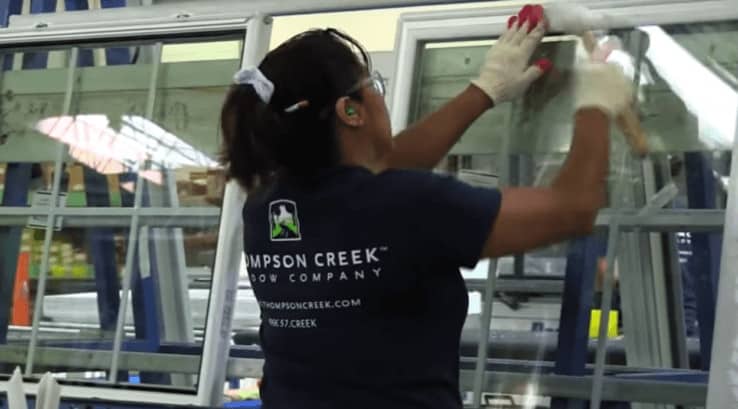Part of the decision of choosing replacement windows involves choosing what window frame types you want. There are several to pick from, and each comes with its own set of pros and cons. Knowing what your options are and the potential benefits and drawbacks for each will help ensure you choose the best window frames for your home and your needs.
There are four types of window frames to choose from, including vinyl, wood, aluminum, and fiberglass. In this guide, you’ll learn more about the important differences that can have an impact on your decision.
Vinyl Window Frames
Vinyl frames are made from polyvinyl chloride, or PVC. This type of window frame is one of the most popular in use today because they are both affordable and have good insulative properties. Because vinyl frames are made by a process called extrusion, they can easily be customized for almost any type of window style.
Vinyl windows are preferred by many homeowners for a number of key reasons, including their affordable price, durability, and easy upkeep. Available in an array of standard and custom colors to complement every taste and style of home, vinyl retains its color well over time, as it’s designed to brave the daily elements, including fade from sunlight. One important consideration to make is that while painting vinyl windows is an option, it is best for the manufacturer to paint the windows.
Vinyl window frames will not crack or peel, or bend or warp, and they can be painted by the window manufacturer.
Wood Window Frames
Wood frames are popular, but they require a lot of maintenance. Maintenance is essential when you have wood frames because if the wood is not resealed or repainted in a timely manner, the wood will be at risk of expansion and contraction due to moisture changes. Wood is not suitable for all climates, as it can be susceptible to rot and weathering in areas where there is very wet weather. Wood windows can become difficult to open and close when they warp, or swell due to weather conditions.
Commonly seen in slightly older homes, wooden frames are an attractive option for many house styles, particularly historical homes. However, while beautiful, wood’s downsides are found in its inherent flaws as a natural material; namely, it is very susceptible to water and heat damage.
When cared for properly, however, they can last for decades. In fact, there are homes that are hundreds of years old, and they still have their original wooden window frames in place. As you might expect, wooden windows are also among the most expensive you can buy.
Aluminum Window Frames
Aluminum window frames are strong, long-lasting, and require very little maintenance. Aluminum frame windows are popularly chosen for their reasonable cost and relative ease of upkeep. However, as a metal, they are a natural conductor of heat, losing it easily. They can stand up to the elements, and unlike other materials, aluminum won’t rot or mold. The biggest problem facing aluminum windows is the fact that they aren’t as energy efficient as other window frame materials. Coupled with them being among the more expensive options (though not as expensive as wood), their limitations on energy efficiency can make aluminum windows ideal only for homes located in certain climates.
While they can be a cost-effective consideration for warm climates, they are not designed for Mid-Atlantic winters. This makes aluminum frames among the least energy-efficient options on the market for areas with cool and cold climates.
Fiberglass Window Frames
Fiberglass windows are very durable, easy to maintain, and can resist weather and temperature changes better than any other material. Because fiberglass and the glass panes used to make up windows are so close in composition, the materials expand and contract at about the same rate during temperature changes.
However, there are a few important fiberglass considerations to make. One of the primary limitations of fiberglass frames is their complicated manufacturing process. This can raise the price of the frames, while also limiting the number of available sizes. If a homeowner opts for fiberglass windows and requires a size that isn’t available, the project may necessitate the use of shims, additional insulation, or other modifications that can ultimately reduce the energy-efficiency of the windows. Among the other drawbacks associated with fiberglass is the fact that these windows can be as expensive as windows made from wood. Plus, the finish on the windows can look dull and often needs to be painted to help improve its appearance. It can be hard for someone to tell a fiberglass window frame apart from a vinyl one, and it is the price difference that makes vinyl such a more popular choice than fiberglass.
Wood-Clad Window Frames:
To answer for both durability and desired style, some homeowners opt for combination window frames, a popular type of which is wood-clad frames. This wooden frame type is clad, or covered, in a more durable material on its exterior – often vinyl or aluminum. On its interior, the natural wood can be enjoyed without worry. The downside to this “best of both worlds” solution is its cost, which is likely to be even higher than wood alone.
Choosing the Best Window Frames for Your Home
If you’re not sure which type of window frame material will work best for your home, let the experts help. Just contact the window experts at Thompson Creek today and we can help you make the right decision for your home, your needs, and your budget. We custom design, build, and install our windows, so no matter which frame material you choose, you’re guaranteed beautiful windows that were made just for your home. Contact Thompson Creek today and get a free estimate for your new window installation.


